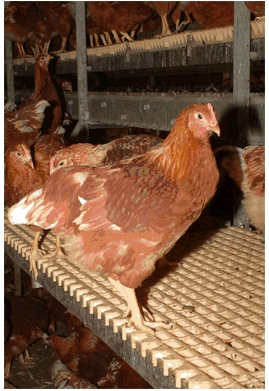WP 7: Integrated welfare assessment
WP7 was focussing on the evaluation of welfare in various housing systems. This was done by combining the results of all other WPs. The main work for WP7 therefore was scheduled in the second year of the project. In the first year literature have been reviewed to study possible techniques to evaluate welfare of laying hens.
The outcome of the other WPs did not allow a statistical analysis. Therefore the evaluation of welfare in WP7 was done through a presentation of risk factors and advantages an disadvantages of various housing systems. Both the approach and the draft have been discussed with the stakeholders. The final report first considers the approaches to welfare assessment and integration, and then discusses the evidence available to the LayWel project for comparing welfare of laying hens in different systems. The methodology used in this report is then outlined before welfare indices are compared within and between systems. Results are summarised in a colour-coded table that estimates the risks to welfare within and between systems for a range of indices. The advantages and disadvantages of the three main categories of housing system are then discussed. The report is concluded with a list of recommendations that highlights areas for future research and development as well as some of the most important indicators of welfare that should be routinely and frequently monitored on farm.  The conclusions in the report are that, with the exception of conventional cages, all systems have the potential to provide satisfactory welfare for laying hens. However this potential is not always realised in practice. Among the numerous explanations are management, climate, design, different responses by different genotypes and interacting effects. For example there was different use of nestboxes in furnished cages by different genotypes. The design of small furnished cages also had a significant impact on dustbath use.
The conclusions in the report are that, with the exception of conventional cages, all systems have the potential to provide satisfactory welfare for laying hens. However this potential is not always realised in practice. Among the numerous explanations are management, climate, design, different responses by different genotypes and interacting effects. For example there was different use of nestboxes in furnished cages by different genotypes. The design of small furnished cages also had a significant impact on dustbath use.
All cage systems tend to provide a more hygienic environment with low risk of parasitic disease. There is possibly a high risk of poor welfare on a flock basis in all systems with larger group sizes (above approximately 10-15 birds) from damaging pecking and cannibalism. All laying hens also are at high risk from sustaining fractures both during the laying period and at depopulation. There is evidence that both these problems are associated with genetic selection for high productivity. Some existing genotypes (mainly white feathered) show a lower tendency for damaging pecking. Much greater emphasis should be placed on selecting genotypes with reduced damaging feather pecking tendencies for use in alternative housing systems for laying hens. Recent studies have shown that bone strength can be improved in laying hens by selection over only one or two generations without a great decrease in productivity. For good laying hen welfare it is a priority that action be taken to reduce the current unacceptable level of fractures sustained during the laying period in all systems apart from conventional cages. This is likely to involve a combined approach of selective breeding, plus refinements to design and management including lighting.
Conventional cages do not allow hens to fulfil behaviour priorities, preferences and needs for nesting, perching, foraging and dustbathing in particular. The severe spatial restriction also leads to disuse osteoporosis. We believe these disadvantages outweigh the advantages of reduced parasitism, good hygiene and simpler management. The advantages can be matched by other systems that also enable a much fuller expression of normal behaviour. A reason for this decision is the fact that every individual hen is affected for the duration of the laying period by behavioural restriction. Most other advantages and disadvantages are much less certain and seldom affect all individuals to a similar degree.
| Description | download |
| 7.1 Overall strengths and weaknesses of each defined housing system for laying hens, and detailing the overall welfare impact of each housing system | |
| 7.1 Manual that can be used to audit the welfare of laying hens at a farm level in whatever housing system they are held |